Verti-Ghost
I look for answers within (read: wrestle with) cinematic giant VERTIGO.
It must be with great trepidation that you should attempt to write something (anything) about Alfred Hitchcock’s masterpiece Vertigo. This is for two reasons; the first is that you acknowledge that you’re completely out of your depth. What could possibly be brought to the table or what new light could be shed upon this monumental classic that hasn’t been written, studied, analysed, scrutinised or agonised over before? You have been left abandoned in such a state of awe at its sheer brilliance countless times before, therefore even the thought of projecting an opinion of your own should be rendered utterly futile, preposterous, and even laughable. It’s far too grand for the likes of you, with your sickening gushes, your whining recommendations and no one cares to humour you as you recall the first time you laid eyes upon it and fell head over heels, for it is well understood that almost anyone who’s experienced Vertigo has undergone an equivalent emotional reaction. Yes you watched the master’s masterful works in chronological order, each film as mesmerising as the next but it’s also true that you just kept coming back to your true love Vertigo time and time again. But never forget that your sentimental little relationship is far from special. Now, attempt to form some distance and save yourself the heavy burden of such a discussion by quickly and very fucking’ humbly bringing to light your mere observation then be on your merry way.
There is an unspoken Vertigo law or etiquette rather, that you simply do not tread upon or alter anyone’s perceptions of this film for it is art and its interpretations are open and varied. So don’t try to pitifully wow us by theorising to mask your deep love and certainly do not try to claim Vertigo as your very own, you’re not privileged enough to address the film or its creator on any personal level and most certainly not on an academic one. They are both far too majestic for the likes of your unworthy, sporadic and pathetic little thoughts that you simply must commit to words. And just who, by the way are you anyway, a Vertigo fan? A Hitchcock fan? Self-professed cinephile? Well the world’s full of such ‘fans’ so the likes of you and whatever it is you need to get off your chest regarding this exalted giant of the cinema better be worth someone’s while. Why, if Hitchcock were to suddenly rise from the dead right here and now you’d be lucky to receive a micro-second of his precious time. If anything, he would lock you in a cell to teach you a lesson like his father before him. He’d make you feel so inadequate with subtle but punishingly scathing insults that you’d shrivel to the size of his steak lunch, whereby he would most certainly chew you up, devour you and wash you down with Brandy and once discovering that you’re not to his taste he would take delight in spitting you back out again. Now state your business, flee, and don’t come sniffing around here again!
OK! I admit it I am no one, nothing and I don’t belong here but alas I must persevere in the face of such daunting Hitchcokian adversity. Please forgive me Late-Great-Master Hitchcock and the film world at large for I bare the audacity to embark headlong into the eye of the spiral by posting my perceptions on our most-adored and ever-beloved Vertigo.
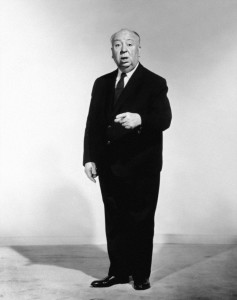
Where was I? Secondly, and far more importantly, how the hell can you even begin to talk about any aspect of the movie without repeating the entire plot? I understand the relevance of reiterating before attempting to dive in and write anything substantial about a film especially when offering potential insight (regardless as to whether the reader has seen the movie countless times or not as yet had the pleasure), but this is Vertigo we’re talking about, seriously, where do you even begin? Let’s face it; the task of simplifying the plot alone could take up to 30 pages. Then once we’ve churned out everything of relevance you’re only half way there. Don’t dare leave without examining the inumerable paramount themes, motifs and symbolisms. You could send yourself mad questioning the meaning behind every choice the director skilfully planted on screen – spiralling hair, mirrors conveying ‘the double’, clues hidden in dreams and trance sequences, or the continuous use (and relevance) of the colour green. And be damned if you think you can get away without addressing Hitchcock’s trusted go-to team. I’m referring to Bernard Herman’s invaluable score, Saul Bass’ stunning opening titles, and Edith Head’s fabulous wardrobe (even the costumes tell a story). Then dig a little further and you plunge into the twisted mindset of the director himself. It’s no mystery that Hitchcock played the puppet master to his blonde leading ladies and the lines not only start to blur but they mesh with a director’s bleeding heart on this one. Scottie’s (James Stewart) obsession with and compulsion to mould Judy (Kim Novak) directly mirrors Hitchcock’s own lustful fascinations. It was no secret that he would later enforce his highly subjective career ideas and manipulate poor Tippy Hedren to awkwardly painful results.
On paper Vertigo would surely sound messy and convoluted even though it’s structurally flawless and completely enthralling from start to finish, but the main reason I care to stare this cinematic titan right in the face is because there’s one aspect of Vertigo that plagues my mind. I’ve had a nagging sensation that I felt the first time I saw it and it has continued to provoke me ever since, but of course it unfortunately won’t make a lick of sense without a comprehensive rundown of how each layer unfolds. So before I delve any further I present the plot here in point form. If I had a gun to my head and was asked to sum up the complexities of Vertigo in a brief sentence complete with spoilers and if I was also to side with the male protagonist (as the hopeless romantic Judy is another story unto itself) then I’d say: ‘A former detective is lied to and left heartbroken’ or if I’m to be entirely honest a tagline could read ‘Scottie gets screwed!’ as below:
- Scottie (a detective) watches his friend fall to his death. Screwed.
- Scottie develops a fear of falling and quits. Screwed.
- After some convincing, an old collage buddy, Gavin, asks him to follow his possessed wife Madeleine, to which he agrees. Pass.
- Follows possessed wife to various locations and with the help of a local historian discovers that she is possibly possessed by her great-grandmother Carlotta Valdes. Screwed.
- Carlotta committed suicide and Scottie saves the possessed Madeleine from doing the same thing when she jumps into the San Francisco bay. Screwed.
- They officially meet and spend the next day together. Love is professed and ensues. Pass.
- Scotty examines her cloudy nightmarish thoughts and leads her to a bell tower by the ocean which he believes is where her dreams are calling her. Pass.
- Madeleine runs up the stairs of the bell tower. Screwed.
- Scottie’s condition makes him unable to follow her to the very top of the stairs. Screwed.
- Madeleine jumps to her death. Screwed.
- Scottie has a meltdown, is locked up in a sanatorium and upon release proceeds to frequent the places he followed Madeleine. Screwed.
- Scottie spots a girl that looks a tad too similar to Madeleine, courts her. Says her name’s Judy. Screwed.
- The Twist: Judy writes a letter explaining that she pretended to be Gavin’s wife Madeleine. Judy was involved in a plot to kill Gavin’s real wife. Gavin was holding his wife’s corpse atop the bell tower stairs and threw her from the tower knowing Scotties condition would prevent him from walking up the stairs and thus making him the alibi. Screwed.
- Judy changes her mind and rips up the letter. Screwed.
- Scottie becomes over-obsessed and physically transforms Judy to look like the Madeleine he fell in love with. Judy plays along because she has actually been in love with Scottie this whole time. Screwed.
- Scottie notices Judy wearing a necklace that she also wore as Madeleine which belonged to Carlotta (as seen in a painting of Carlotta which the wandering Madeleine would often visit) and pieces together the truth, the murder plot, the entire lie. Screwed.
- Pretending he hasn’t realised the truth he returns Judy to the bell tower. Screwed.
- Determined to reach the Bell tower and thus overcoming his fear, Scottie (successfully) pulls Judy to the top of the stairs and admits he knows the truth that Judy is Madeleine, the Carlotta possession was all an act and that the suicide was in fact part of a murder. Screwed.
- Judy confesses. Says she was paid to play Madeleine. Screwed.
- Judy holds firm that she despite the deceit she still loves and always loved Scottie. Pass.
- Scottie embraces her. Pass.
- Startled by a nun who comes up through the bell tower trap door, Judy falls backwards to her death. Screwed.
The one thing that has bothered me or forced me to re-evaluate everything I’ve seen in Vertigo mainly centres on plot points 7 and 22, the nightmarish thoughts and the climactic death. The most enchanting scenes in Vertigo I find are when Scottie is following Madeleine under the assumption that she is in a state of possession or trance. Maybe Kim Novak played the possessed-wife scenes a little too well (Hitchcock was apparently unhappy with Kim Novak’s performance for his first choice was Vera Miles who was pregnant at the time) but between his beautiful hazy imagery and overall expertise when conveying voyeurism on screen, I’m completely caught up in the moment. As is Scottie who becomes utterly convinced that he is watching a disturbed woman revisit all the haunts of the ghost ancestor that inhabits her body. Even more convincing again is when the two finally become acquainted and she is able to verbalise her out of body experiences. Her bewitching and peculiar speeches are equally as striking as the observations that Scottie has only witnessed from a far previously. There are very few moments where the two actually converse but as her mind trails off every word should be savoured to help piece together the ghost’s alleged past and to help solve the mystery of her puzzling behaviour. And because we have surrendered to the idea that an evil spirit is responsible for her actions, to later uncover that a) she was acting, b) she’s not the elegant woman that had us captivated, but a role-playing savvy mistress named Judy and c) that any notions of love for Scottie have been challenged and replaced by wealth, we’re left quite disillusioned to say the least.
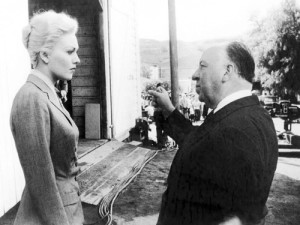
Scottie’s outrage and aggressive reaction is not at all unwarranted and although it’s a remarkable twist, to think that he has been fleeced, complete with elaborate ghost tales and the promise of love is a tough pill to swallow and one hell of a cruel hoax, no more for Scottie than for us, the shell-shocked spectator. And yes Scottie should never have allowed himself to be taken by a woman who he assumed to be his buddy’s wife in the first place, so technically he got his just desserts but Hitchcock sure isn’t labouring on that! Even Scottie’s not convinced, for during the final scene in the bell tower he switches between calling her Judy and Madeleine. If only she had given him her compassionate letter (13), but of course it’s that Hitchcock puppetry and the way he cleverly keeps the audience informed enough to set-up further astonishing outcomes that grants him the title Master Of Suspense.
It may sound absurd but the conclusion I’ve drawn with each viewing is that Carlotta the ghost was real! Real I tell you! Carlotta is taking control over Judy who we understand to be Madeleine with all her ghoulish powers from beyond the grave. The trances and cryptic echoes from the past where we are lead to believe was all pretend to lure Scottie into becoming the perfect alibi, were in fact premonitions of Judy’s actual demise.
I commonly find that whenever I see a written synopsis of Vertigo that the film’s final moment is described as Judy being startled by something and then falling to her death. But what’s rarely mentioned or at least expanded upon is that she is startled by a nun. It’s clearly a nun that emerges from the trap door not a mere ‘black’ figure as I’ve so often read. So I watched that ending again and freeze framed just to make sure that you can in fact tell that it is a nun and here’s what I found: yes it is and yes you can. I accept that once the nun fully emerges she casts a black menacing figure and that it was certainly deliberate to lose her human definition but it was always a nun coming out of that trap door. Maybe I’m missing something or perhaps it’s so plainly obvious that I needn’t broach the subject but no one seems to question why a nun should startle someone to fall to their death. For instance, if Hitchcock is the master of suspense then Donald Spoto with three books about Hitchcock to his name, is the master of Hitchcock. In fact he first met his subject after writing a piece on Vertigo, so I figure if anyone would know something that the rest of us might have overlooked it would be Spoto. And yet his plot summary of Vertigo in his incredible book (and ultimate companion when watching any Hitchcock number) The Art Of Alfred Hitchcock refers to the cause as ‘frightened by footsteps in the dark’. To be fair, later in the piece he does mention ‘the ghostly nun rising as if from the past to suggest an avenging Carlotta or Madeleine’. Now that I like, but I can’t abandon my initial impressions which suggest the opposite, that the ghost is inside Judy not rising from the trap door to get her. Although later again Spoto suggests that Judy sees a ‘black-shrouded figure rise up’. Am I’m alone on this one?
I never questioned why she got such a fright as to fall because I figured the possessed Madeleine (Judy?) had a hang up with a nun as is mentioned during one of her trances. It’s either a throw away comment or a remark of significance that forces you to rethink the film in its entirety (as though you don’t already have to rethink everything anyway). Whilst in this trance Madeleine says “Sister Teresa would scold us.” This scene is at the stable beside the bell tower; just before making her move to run to the top to leap to her supposed death or rather carry out Gavin’s plan (between 7 & 8). Even Scotties reply is telling “and it’s all real”. It might be a tad excessive and perhaps I’m over examining this one line but Vertigo does not have any accidental dialogue or actions (apparently the extras and cars that pass by windows in the background were all carefully selected). And once we reach the end of the film you’re left in a melancholic cloud as we wave goodbye to a grief stricken Scottie looking down upon his deceased lover. To suggest Judy was superb at playing Scottie for a fool is a much easier premise to accept if all a little too superb! Enough that it’s kept me restlessly off kilter, and I’m not content to wrap this one in a neat little bow just yet. I think Hitchcock was implying that by accepting this eerie undertaking, Judy had become susceptible to true possession. To alleviate the feeling of Scottie being cheated and swindled let’s assume that upon involving herself in this mystical murder plot that the ghost of Carlotta Valdes has gained control over Judy’s thoughts and ultimately her actions.
There’s no shortage of elements presented or enforced from Hitchcock’s perspective either. The most blatant is the way Judy transforms into Madeleine at the insistence of a by now distraught Scottie and is encompassed in the green neon lights from beyond the window as though a ghost has just walked through the door (15). There’s the dreamlike chases, the eerie sunlight creeping in through the woods, not to mention the chilling exchange about when she supposedly died (a century or so before this moment) by looking at the life of a tree trunk via its circles, and the fitting metaphoric remark from Scottie when referring to the tree ‘always green, ever living’ (6). Bernard Herman’s score which can give you the absolute creeps and break your heart all over again at the flick of his wrist. Also while Madeleine and Scottie are on their first outing once acquainted she’s practically dressed as a nun or at least the antithesis of a nun. It’s as though the colours have deliberately been reversed, she’s draped in white and wearing glimpses of black attire and scarf under the very angular coat that in so many ways resembles the pointy folds of a Catholic nuns habit.
But then again, it’s relatively fair to conclude that the whole picture is haunting; you could make a case for every scene but to stay on one train of thought and when considering that shot for shot and word for word nothing was left to chance then what’s with the line about Sister Teresa? We know from the historian at the book store that Carlotta arrived to San Francisco from ‘somewhere small …a mission settlement’, then she was a cabaret dancer and had a child with a man that eventually threw her away leaving her manically depressed (Gavin also disappears from Judy once his dead wife’s case was neatly wrapped up). Carlotta’s average life complete with abusive nuns, an escape to a city that was unkind to her, a child that was taken and a lover that left her is so tragic that eventually it ended in suicide. So roaming the earth as a ghost has compelled her to take possession of anyone who should tread over her grave, perhaps? Surely if the Sister Teresa line was simply intended to highlight the simple fact that there happens to be nuns all over the grounds then it would have been disused. I prefer to believe that she was remembering something from another time whilst in her trance. So when Judy see’s the nun rise from the trap door of the bell tower, the ghost of Carlotta Valdes embodies her or at least a glimpse of the tortured Carlotta peaks through as she remembers the ‘scolding’ or whatever other awful things the nuns did to her. Succumbing to Carlotta’s ghostly influence she is transported to a scared little girl once more, and frightened of the nun, falls backward in terror to her own death.
The final point, which I found unconvincing, was how Scottie’s old buddy Gavin could have so cleverly executed such a detailed murder plot with performances of such conviction. We never really get a clear sense of the orchestrator at work. And yet he supposedly conjured up a fairly intricate and perfectly engineered plan to get away with it all. Now whoever this Gavin is – he’s your McGuffin! A murdering mastermind with a scheme so strategically tight that it fools a former detective, an entire court and yet his colourful story is laced with ghosts of all things! This makes me wonder how much of the story was part of Madeleine’s true family history (obviously some if the Historian had information – 4) and how much had Judy fabricated from her own life? In light of the Sister Teresa scolding maybe Gavin dismissed details and merely told his mistress ‘We’ve still got the issue with my wife so come up with a story that ends with me throwing her corpse off that bell tower and let me know the details, OK? Thanks’. This allows Judy to draw from the far reaches of her mind and allows us to believe that the Carlotta ghost story belongs exclusively to Judy. Even if it’s agreed that Gavin hatched a plan then perhaps Judy was allowed to adlib and inadvertently allow herself to become possessed as the tale told to Scottie by Gavin suggests. Gavin never did get to see her spellbound and he also never did have the pleasure of hearing a translation of her trances.
It’s quite clear that although Hitchcock was considered the master of suspense, the few times he made a thriller with an emotional quality (Notorious also springs to mind) he transcended the thriller genre to become the master of film, period! That’s why I continually refer to Hitchcock here as the story teller and not Boileau-Narcejac who wrote the original book The Living & The Dead or Samuel A. Taylor who wrote the final screenplay because we now know Hitchcock over-saw everything especially from inception, as his favourite part of the film making process was pre-production and script-wise altered everything as he saw fit. Therefore part of me can’t help but feel that this leader of the macabre wanted us to believe in his ghost story, it’s written all over Judy’s face in terror as she lays eyes on the nun rising from the floor and in that moment of panic and with a mere look in her eyes, everything needs to be reconsidered.

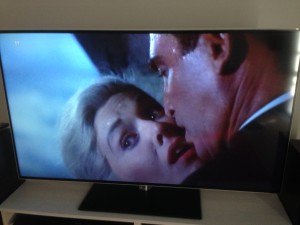
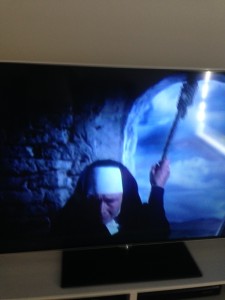
With each revisit my thoughts are as grey as Madeline’s suit that Scottie had to get just right, my head as foggy as the San Francisco Bay where Madeleine makes a bold leap of faith and I’m left feeling as cold as she looked after Scottie rescued her. The overwhelming questions I’m always left with is ‘could she really have been possessed? Was there some truth behind the ghost of Carlotta Valdes? Was the trances not an act but a premonition of Judy’s own demise?’ and usually it’s too hard a task to retrace my steps backwards to find any definite answers for the film is truly a mystery but for once I should just confidently answer yes to all. If Hitchcock wants me to believe in his ghost tale then I’m going to finally surrender and believe it, every last haunting second of it.
When I was around twenty-seven years old in the dead of winter I paid London a visit and found myself lodging in the very town where Hitchcock was raised, Leytonstone. Seventeen of his films were represented as mosaics and lined along the train station walls and I marvelled at … Oi! Enough! Cut that out, you’re done here! Remember what we agreed?
…fine.
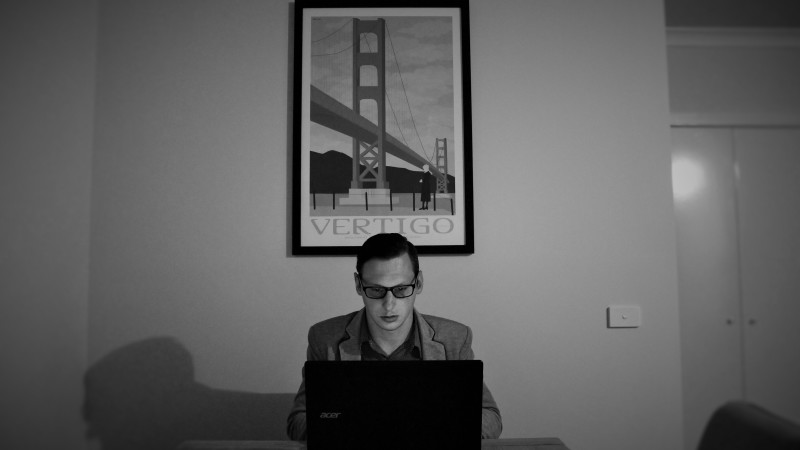
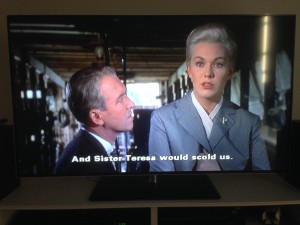
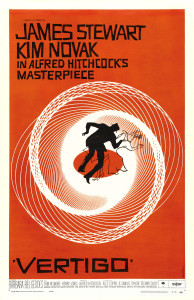
Hi everyone, it’s my first visit at this website, and article is really fruitful for me, keep up posting these content.
Will you mind basically if i quote a couple of your own posts
so long as I provide credit and sources to your weblog?
My blog site is in the very same area of interest as yours and my visitors would definitely take advantage of
a few of the information you provide here.
Please inform me if this ok along. Many thanks!
Awsome site! I am loving it!! Will come back again. I am taking your feeds also.
Thanks for every other excellent article. The place else may just anybody get that type of information in such an ideal means of writing?
I have a presentation next week, and I am at the look for such information.
Thank you for finally talking about >Verti-Ghost <Loved it!
I couldn’t resist commenting. Exceptionally well written!
I constantly emailed this blog post page to all my associates, because if
want to read it next my contacts will too.
You can definitely view your enthusiasm within the article you write.
The world hopes for more passionate writers as if you who are not afraid to
say the way that they believe. Always follow your heart.